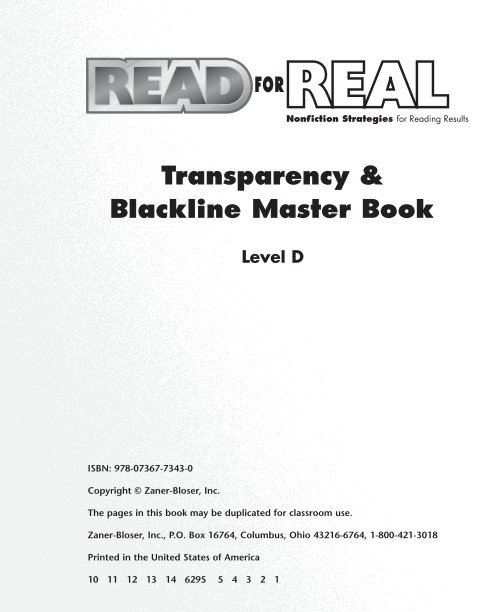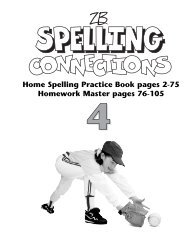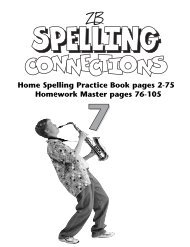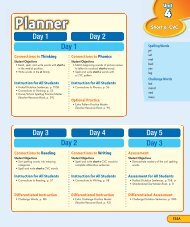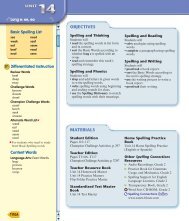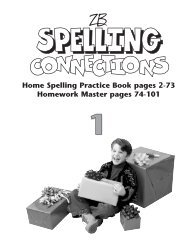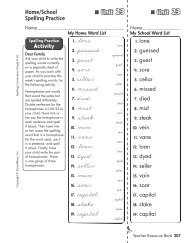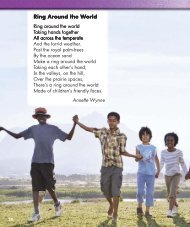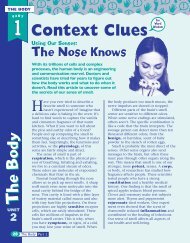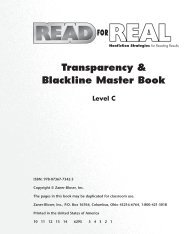Level D - Zaner-Bloser
Level D - Zaner-Bloser
Level D - Zaner-Bloser
You also want an ePaper? Increase the reach of your titles
YUMPU automatically turns print PDFs into web optimized ePapers that Google loves.
Transparency &<br />
Blackline Master Book<br />
ISBN: 978-07367-7343-0<br />
Copyright © <strong>Zaner</strong>-<strong>Bloser</strong>, Inc.<br />
FOR<br />
<strong>Level</strong> D<br />
The pages in this book may be duplicated for classroom use.<br />
Nonfiction Strategies for Reading Results<br />
<strong>Zaner</strong>-<strong>Bloser</strong>, Inc., P.O. Box 16764, Columbus, Ohio 43216-6764, 1-800-421-3018<br />
Printed in the United States of America<br />
10 11 12 13 14 6295 5 4 3 2 1
School to Home Letter<br />
Unit 1<br />
Practice the Strategy<br />
Scaffolded Spider Map for The Scoop on Scorpions . . . . . . . . . . . . . Transparency & BLM 1<br />
Answer Key<br />
Apply the Strategy<br />
Spider Map for Deep-Sea Dangler . . . . . . . . . . . . . . . . . . . . . . . . . . . Transparency & BLM 2<br />
Answer Key<br />
Unit 2<br />
Practice the Strategy<br />
Scaffolded Problem-Solution Frame for Writing in the Dark . . . . . . . Transparency & BLM 3<br />
Answer Key<br />
Apply the Strategy<br />
Problem-Solution Frame for Reading With Your Fingers . . . . . . . . . . Transparency & BLM 4<br />
Answer Key<br />
Unit 3<br />
Practice the Strategy<br />
Scaffolded Web for And the Earth Shakes . . . . . . . . . . . . . . . . . . . . . Transparency & BLM 5<br />
Answer Key<br />
Apply the Strategy<br />
Web for And the Earth Explodes . . . . . . . . . . . . . . . . . . . . . . . . . . . . Transparency & BLM 6<br />
Answer Key<br />
Unit 4<br />
Practice the Strategy<br />
Scaffolded Venn Diagram for Farmer on the Crew . . . . . . . . . . . . . . Transparency & BLM 7<br />
Answer Key<br />
Apply the Strategy<br />
Venn Diagram for Space Psychologist . . . . . . . . . . . . . . . . . . . . . . . . Transparency & BLM 8<br />
Answer Key<br />
Unit 5<br />
Practice the Strategy<br />
Scaffolded Order Chain for The Orphan Trains . . . . . . . . . . . . . . . . . Transparency & BLM 9<br />
Answer Key<br />
Apply the Strategy<br />
Order Chain for Whatever Happened to the Passenger Train? . . . .Transparency & BLM 10<br />
Answer Key<br />
Unit 6<br />
Practice the Strategy<br />
Table of Contents<br />
Scaffolded Time Line for Say to Yourself, “I AM an Artist!” . . . . . . . Transparency & BLM 11<br />
Answer Key<br />
Apply the Strategy<br />
Time Line for Sculpture—It’s the Whole World . . . . . . . . . . . . . . . . .Transparency & BLM 12<br />
Answer Key<br />
K-W-L Chart . . . . . . . . . . . . . . . . . . . . . . . . . . . . . . . . . . . . . . . . . . . . . .Transparency & BLM 13<br />
Suggestions<br />
for<br />
Use<br />
Strategy Transfer Chart . . . . . . . . . . . . . . . . . . . . . . . . . . . . . . . . . . . . .Transparency & BLM 14<br />
Suggestions<br />
for<br />
Use
Dear Family,<br />
School to Home<br />
Good reading comprehension is of vital importance to your son or daughter. Nonfiction<br />
textbooks in science, social studies, and math can be especially challenging. In addition,<br />
standardized tests demand that students read and understand quickly. Outside of the<br />
classroom, the challenge continues as students read magazines, newspapers, instructions,<br />
and other types of nonfiction material.<br />
Your child is currently using Read for Real: Nonfiction Strategies for Reading Results.<br />
This program teaches valuable reading comprehension strategies to help students become<br />
better nonfiction readers. Here is a list of the strategies and how they work:<br />
When to Use the Strategy What the Strategy Says What the Strategy Means<br />
Please discuss the strategies with your son or daughter while he/she is doing homework.<br />
You might even use some of the strategies as you and your child discuss television<br />
shows, movies, and newspaper or magazine articles.<br />
Thanks for your help!<br />
Sincerely,<br />
Before Reading<br />
During Reading<br />
After Reading<br />
Preview the Selection<br />
before you begin to read.<br />
Activate Prior Knowledge<br />
about the topic.<br />
Look at the pictures, headings, etc., to<br />
get an idea of what it will be about.<br />
Think about what you already<br />
know about the topic.<br />
Set a Purpose for reading. Decide what you want to learn as<br />
you read.<br />
Make Connections with<br />
what you are reading.<br />
Interact With the Text<br />
as you read.<br />
Clarify Understanding<br />
of what you are reading.<br />
Think about how your life and knowledge<br />
fit in with what you are reading.<br />
Ask and answer questions about<br />
what you’re reading.<br />
If something doesn’t make sense,<br />
look for clues to help it make sense.<br />
Recall what you just read. Try to remember key facts<br />
or ideas.<br />
Evaluate the selection. Decide whether the selection was<br />
based on facts.<br />
Respond to what you read. Form your own opinion about<br />
what you’ve read.
Copyright © <strong>Zaner</strong>-<strong>Bloser</strong>, Inc.<br />
<strong>Level</strong> D Scaffolded Spider Map for<br />
The Scoop on Scorpions<br />
Unit<br />
1<br />
Practice<br />
related to spiders,<br />
ticks, and lobsters<br />
covered by hard outer shell<br />
most are less than 2 in., but<br />
some are 8 in.<br />
Food comes to the scorpion<br />
What is a scorpion?<br />
waits for prey to come<br />
near, then grabs with claws<br />
get most moisture from prey<br />
Spider Map<br />
The scorpion polka<br />
The Scoop<br />
on Scorpions<br />
eggs hatch inside mother<br />
danger depends on<br />
scorpion’s venom, not size<br />
pincer size good sign of<br />
scorpion’s poison<br />
Big claws, little claws<br />
Shake your shoes<br />
if you get stung, tell an adult<br />
Transparency & BLM #1
<strong>Level</strong> D<br />
Unit<br />
1<br />
Practice<br />
arthropod<br />
related to spiders,<br />
ticks, and lobsters<br />
small nocturnal animals<br />
have claws, can sting<br />
bodies have eight<br />
segments and eight legs<br />
covered by hard outer shell<br />
live in many different habitats<br />
Possible Answers for<br />
Transparency & BLM #1<br />
The Scoop on Scorpions<br />
about 2,500 species<br />
most are less than 2 in., but<br />
some are 8 in.<br />
food hard to find in desert<br />
scorpions try to use<br />
little energy for prey<br />
waits for prey to come<br />
near, then grabs with claws<br />
usually bites with fangs<br />
uses stinger on large prey<br />
are nearsighted, see<br />
best at night<br />
Food comes to the scorpion<br />
get most moisture from prey<br />
Scaffolded Spider Map for<br />
What is a scorpion?<br />
Spider Map<br />
The scorpion polka<br />
The Scoop<br />
on Scorpions<br />
unusual mating dance<br />
eggs hatch inside mother<br />
babies born alive, often<br />
ride on mother’s back<br />
danger depends on<br />
scorpion’s venom, not size<br />
only deadly scorpion is in<br />
western U.S.<br />
small pincers—stronger venom<br />
Big claws, little claws<br />
pincer size good sign of<br />
scorpion’s poison<br />
large pincers—weaker venom<br />
Shake your shoes<br />
scorpions come inside and hide in dark<br />
places, like in shoes and under blankets<br />
if you get stung, tell an adult<br />
Copyright © <strong>Zaner</strong>-<strong>Bloser</strong>, Inc.
Copyright © <strong>Zaner</strong>-<strong>Bloser</strong>, Inc.<br />
<strong>Level</strong> D<br />
Unit<br />
1<br />
Apply<br />
Deep-Sea Dangler<br />
Deep-Sea<br />
Dangler<br />
Spider Map for<br />
Spider Map<br />
Transparency & BLM #2
<strong>Level</strong> D<br />
Unit<br />
1<br />
Apply<br />
anglerfish dangles bait in water<br />
Possible Answers for<br />
Transparency & BLM #2<br />
Deep-Sea Dangler<br />
live in darkness, below 3,000 feet<br />
The fishing fish<br />
Anglerfish life cycle<br />
more than 200 kinds<br />
use “bait” to attract prey<br />
anglerfish lays eggs<br />
eggs float to surface<br />
only females glow<br />
adults are in darkness<br />
may be from 8 to 40 inches long<br />
as young grow, they drift downward<br />
Spider Map<br />
males smaller, attach to side of female<br />
female fishes and eats for herself<br />
and attached male<br />
Spider Map for<br />
Deep-Sea<br />
Dangler<br />
below 6,000 feet,<br />
all animals glow<br />
light is bioluminescent<br />
most anglerfish have<br />
bioluminescent bacteria<br />
Glowing from within<br />
dinner comes from surface—no<br />
plants grow in darkness<br />
deep-sea fish are<br />
scavengers or predators<br />
Dinner in the deep<br />
may use currents to pull in prey<br />
anglerfish have huge jaws<br />
Copyright © <strong>Zaner</strong>-<strong>Bloser</strong>, Inc.
Copyright © <strong>Zaner</strong>-<strong>Bloser</strong>, Inc.<br />
<strong>Level</strong> D Scaffolded Problem-Solution Frame for<br />
Writing in the Dark<br />
Unit<br />
2<br />
Practice<br />
Problem Box<br />
Solution Box<br />
End Result Box<br />
What is the problem?<br />
Problem-Solution Frame<br />
Writing in the Dark<br />
Why is it a problem? She had to wait until she got home to finish<br />
her homework.<br />
Who has the problem? Becky Schroeder<br />
Solutions<br />
First, she did research to find out<br />
how and why some things glow.<br />
Then she bought some phosphorescent<br />
paint.<br />
Becky’s father helped her get a<br />
patent for her invention.<br />
Becky thought of ways to improve<br />
her Glo-Sheet. She attached a<br />
battery.<br />
She made many improvements.<br />
Results<br />
She covered a clipboard with the<br />
special paint. Then she put a<br />
piece of paper on the clipboard.<br />
When she wrote, the writing<br />
showed up in the dark.<br />
Nobody could steal her invention<br />
or get credit for it.<br />
The Glo-Sheet stayed lit up for<br />
longer periods of time.<br />
She got a new patent for each<br />
improvement.<br />
Transparency & BLM #3
<strong>Level</strong> D<br />
Unit<br />
2<br />
Practice<br />
Problem Box<br />
Solution Box<br />
End Result Box<br />
Possible Answers for<br />
Transparency & BLM #3<br />
Scaffolded Problem-Solution Frame<br />
Writing in the Dark<br />
Problem-Solution Frame<br />
Writing in the Dark<br />
What is the problem? Becky couldn’t do her homework in the dark.<br />
Why is it a problem? She had to wait until she got home to finish<br />
her homework.<br />
Who has the problem? Becky Schroeder<br />
Solutions<br />
First, she did research to find out<br />
how and why some things glow.<br />
Then she bought some phosphorescent<br />
paint.<br />
Becky’s father helped her get a<br />
patent for her invention.<br />
Becky thought of ways to improve<br />
her Glo-Sheet. She attached a<br />
battery.<br />
She made many improvements.<br />
Results<br />
She covered a clipboard with the<br />
special paint. Then she put a<br />
piece of paper on the clipboard.<br />
When she wrote, the writing<br />
showed up in the dark.<br />
Nobody could steal her invention<br />
or get credit for it.<br />
The Glo-Sheet stayed lit for<br />
longer periods of time.<br />
She got a new patent for each<br />
improvement.<br />
Becky invented a useful product. People could read menus more<br />
easily in dimly lit restaurants. Doctors could write on patients’<br />
charts at night. Airplane pilots could take notes in the dark.<br />
Copyright © <strong>Zaner</strong>-<strong>Bloser</strong>, Inc.
Copyright © <strong>Zaner</strong>-<strong>Bloser</strong>, Inc.<br />
<strong>Level</strong> D<br />
Unit<br />
2<br />
Apply<br />
Problem Box<br />
Solution Box<br />
End Result Box<br />
Problem-Solution Frame for<br />
Reading With Your Fingers<br />
What is the problem?<br />
Why is it a problem?<br />
Who has the problem?<br />
Problem-Solution Frame<br />
Reading With Your Fingers<br />
Solutions<br />
Results<br />
Transparency & BLM #4
<strong>Level</strong> D<br />
Unit<br />
2<br />
Apply<br />
Problem Box<br />
Solution Box<br />
End Result Box<br />
Possible Answers for<br />
Transparency & BLM #4<br />
Reading With Your Fingers<br />
Louis’s sister made letters out of<br />
straw.<br />
Louis could read the special books<br />
printed with large raised letters.<br />
Louis made a code with holes.<br />
Louis learned about Captain<br />
Barbier’s code of raised dots and<br />
dashes.<br />
Louis stopped using dashes and<br />
made his code with special patterns<br />
of dots.<br />
Problem-Solution Frame for<br />
Problem-Solution Frame<br />
Reading With Your Fingers<br />
What is the problem? Louis was blind.<br />
Why is it a problem? Louis couldn’t see to read.<br />
Who has the problem? Louis Braille<br />
Solutions<br />
Results<br />
Louis could feel their shapes and<br />
knew what they were.<br />
Louis could read, but the books<br />
were huge.<br />
The code was hard to learn and<br />
hard to read.<br />
Louis used a stylus to write the<br />
new code. His classmates loved<br />
the idea.<br />
He had people read books aloud so<br />
he could make his code for other<br />
blind people to read.<br />
Louis invented a code that enabled blind people to read. Now people<br />
all over the world can read by using the Braille alphabet.<br />
Copyright © <strong>Zaner</strong>-<strong>Bloser</strong>, Inc.
Copyright © <strong>Zaner</strong>-<strong>Bloser</strong>, Inc.<br />
<strong>Level</strong> D<br />
Unit<br />
3<br />
Practice<br />
crust is broken<br />
into plates<br />
And the Earth Shakes<br />
The Why and How of<br />
an Earthquake<br />
Scaffolded Web for<br />
Web<br />
crust floats<br />
on mantle<br />
And the<br />
Earth Shakes<br />
2 scales help<br />
describe quakes<br />
comparing seismograph<br />
reports shows<br />
focus of quake<br />
no quakes recorded<br />
in Texas, Alabama,<br />
or Florida<br />
Transparency & BLM #5
<strong>Level</strong> D<br />
Unit<br />
3<br />
Practice<br />
crust is broken<br />
into plates<br />
movement of<br />
plates causes<br />
earthquakes<br />
Possible Answers for<br />
Transparency & BLM #5<br />
And the Earth Shakes<br />
The Why and How of<br />
an Earthquake<br />
most damage caused by<br />
shaking of unsafe buildings<br />
and by liquefaction<br />
take place in<br />
Earth’s crust<br />
Scaffolded Web for<br />
Web<br />
cracks in crust<br />
are faults<br />
crust floats<br />
on mantle<br />
And the<br />
Earth Shakes<br />
Measuring and Comparing<br />
Earthquakes<br />
2 scales help<br />
describe quakes<br />
Richter Scale Modified Mercalli Scale<br />
most happen in Ring<br />
of Fire, in Pacific<br />
no quakes recorded<br />
in Texas, Alabama,<br />
or Florida<br />
The Where of an<br />
Earthquake<br />
also happen in<br />
Europe, Middle East,<br />
Asia, and U.S.<br />
quakes measured by<br />
seismographs<br />
comparing seismograph<br />
reports shows<br />
focus of quake<br />
Copyright © <strong>Zaner</strong>-<strong>Bloser</strong>, Inc.
Copyright © <strong>Zaner</strong>-<strong>Bloser</strong>, Inc.<br />
<strong>Level</strong> D<br />
Unit<br />
3<br />
Apply<br />
Web for<br />
And the Earth Explodes<br />
Web<br />
And the<br />
Earth Explodes<br />
Transparency & BLM #6
<strong>Level</strong> D<br />
Unit<br />
3<br />
Apply<br />
example is<br />
Mount Kilauea<br />
lava flows slowly,<br />
so people can move<br />
to safety<br />
may explode one<br />
time, then flow lava<br />
the next time<br />
Possible Answers for<br />
Transparency & BLM #6<br />
And the Earth Explodes<br />
don't explode,<br />
they flow<br />
Quiet<br />
Volcanoes<br />
Intermediate<br />
Volcanoes<br />
ashes buried<br />
Pompeii<br />
Web for<br />
Web<br />
And the<br />
Earth Explodes<br />
biggest modern<br />
exploding volcano<br />
was Mount Pelé<br />
happen fast and no<br />
warning, so often<br />
many deaths<br />
example is<br />
Mount Vesuvius<br />
killed hundreds<br />
of people<br />
Exploding<br />
Volcanoes<br />
Living With<br />
Volcanoes<br />
crater fills in,<br />
pressure builds,<br />
volcano blows up<br />
biggest explosive<br />
volcano ever was<br />
Krakatau<br />
no eruption, so<br />
people forget, as with<br />
Mount St. Helens<br />
geologists trying<br />
to predict<br />
volcanoes<br />
farmers take risks<br />
because of great soil<br />
Copyright © <strong>Zaner</strong>-<strong>Bloser</strong>, Inc.
Copyright © <strong>Zaner</strong>-<strong>Bloser</strong>, Inc.<br />
<strong>Level</strong> D Scaffolded Venn Diagram for<br />
Farmer on the Crew<br />
Unit<br />
4<br />
Practice<br />
Earth<br />
• plant seeds in soil<br />
and water them<br />
Venn Diagram<br />
Farmer on the Crew<br />
• comes from plants<br />
and animals, not<br />
computers<br />
Space<br />
• artificial Earthlike<br />
conditions<br />
Transparency & BLM #7
<strong>Level</strong> D<br />
Unit<br />
4<br />
Practice<br />
Earth<br />
• plant seeds in soil<br />
and water them<br />
• seeds sprout<br />
• grow with Earth’s air<br />
and sunlight<br />
• real gravity<br />
• use real soil<br />
Possible Answers for<br />
Transparency & BLM #7<br />
Scaffolded Venn Diagram for<br />
Farmer on the Crew<br />
Venn Diagram<br />
Farmer on the Crew<br />
• comes from plants<br />
and animals, not<br />
computers<br />
• need soil, air, and<br />
water<br />
• need gravity<br />
• fresh tastes best<br />
Space<br />
• artificial Earthlike<br />
conditions<br />
• special light bulbs<br />
• pots have mixture of<br />
gases like Earth’s air<br />
• have to spin pots<br />
• use hydroponic liquid<br />
Copyright © <strong>Zaner</strong>-<strong>Bloser</strong>, Inc.
Copyright © <strong>Zaner</strong>-<strong>Bloser</strong>, Inc.<br />
<strong>Level</strong> D<br />
Unit<br />
4<br />
Apply<br />
On<br />
the<br />
Ground<br />
Venn Diagram for<br />
Space Psychologist<br />
Venn Diagram<br />
Space Psychologist<br />
Out<br />
in<br />
Space<br />
Transparency & BLM #8
<strong>Level</strong> D<br />
Unit<br />
4<br />
Apply<br />
On the Ground<br />
• paper and pencil<br />
tests<br />
• interviews<br />
• special tests with<br />
other candidates<br />
• different personalities<br />
may clash<br />
• practice working in<br />
space-like conditions<br />
• can always get away<br />
or quit<br />
Possible Answers for<br />
Transparency & BLM #8<br />
Venn Diagram for<br />
Space Psychologist<br />
Venn Diagram<br />
Space Psychologist<br />
• 2 kinds of doctors:<br />
-research and experiments<br />
-counselors<br />
• interview and test<br />
candidates<br />
• prepare astronauts for<br />
space travel<br />
• crews must work well<br />
together<br />
• astronauts must focus<br />
on goals of the mission<br />
Out in Space<br />
• could be short-term<br />
or long-term<br />
• small place crammed<br />
with people and<br />
instruments<br />
• not much privacy<br />
• can’t get away or<br />
take a walk<br />
• hard to predict longterm<br />
behavior<br />
Copyright © <strong>Zaner</strong>-<strong>Bloser</strong>, Inc.
Copyright © <strong>Zaner</strong>-<strong>Bloser</strong>, Inc.<br />
<strong>Level</strong> D Scaffolded Order Chain for<br />
The Orphan Trains<br />
Unit<br />
5<br />
Practice<br />
Topic<br />
First Step<br />
Next Step<br />
Next Step<br />
Next Step<br />
Next Step<br />
Next Step<br />
Next Step<br />
Next Step<br />
Final Step<br />
The Orphan Trains<br />
Order Chain<br />
Many orphans were in large cities on East Coast.<br />
Charles Loring Brace set up Children's Aid Society.<br />
Members of the Society got groups of kids ready to travel.<br />
Children rode the trains in groups.<br />
Placing agents rode with them.<br />
People in towns met the children to choose who they wanted.<br />
Other children traveled to the next town.<br />
New laws were made to help orphans.<br />
Orphan trains stopped running.<br />
Transparency & BLM #9
<strong>Level</strong> D<br />
Unit<br />
5<br />
Practice<br />
Topic<br />
First Step<br />
Next Step<br />
Next Step<br />
Next Step<br />
Next Step<br />
Next Step<br />
Next Step<br />
Next Step<br />
Final Step<br />
Possible Answers for<br />
Transparency & BLM #9<br />
Scaffolded Order Chain for<br />
The Orphan Trains<br />
The Orphan Trains<br />
Order Chain<br />
Many orphans were in large cities on East Coast.<br />
Charles Loring Brace set up Children's Aid Society.<br />
Members of the Society got groups of kids ready to travel.<br />
Children rode the trains in groups.<br />
Placing agents rode with them.<br />
People in towns met the children to choose the ones<br />
they wanted.<br />
Other children traveled to the next town.<br />
New laws were made to help orphans.<br />
Orphan trains stopped running.<br />
Copyright © <strong>Zaner</strong>-<strong>Bloser</strong>, Inc.
Copyright © <strong>Zaner</strong>-<strong>Bloser</strong>, Inc.<br />
<strong>Level</strong> D<br />
Unit<br />
5<br />
Apply<br />
Topic<br />
First Step<br />
Next Step<br />
Next Step<br />
Next Step<br />
Next Step<br />
Next Step<br />
Next Step<br />
Next Step<br />
Next Step<br />
Final Step<br />
Order Chain for<br />
Whatever Happened to<br />
the Passenger Train?<br />
Order Chain<br />
Whatever Happened to the Passenger Train?<br />
Transparency & BLM #10
<strong>Level</strong> D<br />
Unit<br />
5<br />
Apply<br />
Topic<br />
First Step<br />
Next Step<br />
Next Step<br />
Next Step<br />
Next Step<br />
Next Step<br />
Next Step<br />
Next Step<br />
Next Step<br />
Final Step<br />
Possible Answers for<br />
Transparency & BLM #10<br />
Order Chain for<br />
Whatever Happened to the<br />
Passenger Train?<br />
Order Chain<br />
Whatever Happened to the Passenger Train?<br />
Trains were a favorite way for people to travel.<br />
During the Great Depression, railroads lost money.<br />
During World War II, trains carried goods and troops.<br />
After the war, trains were popular again.<br />
Competition from cars and planes hurt the railroads.<br />
U.S. Postal Service switched from trains to planes.<br />
Congress wanted to keep passenger trains running.<br />
Congress set up the National Railroad Passenger Corporation.<br />
Most of the old locomotives and cars were replaced.<br />
Amtrak and the government work together to keep the trains running.<br />
Copyright © <strong>Zaner</strong>-<strong>Bloser</strong>, Inc.
Copyright © <strong>Zaner</strong>-<strong>Bloser</strong>, Inc.<br />
<strong>Level</strong> D Scaffolded Time Line for<br />
Say to Yourself, “I AM an Artist!”<br />
Unit<br />
6<br />
Practice<br />
as a little girl<br />
as an adult<br />
is successful<br />
Time Line<br />
Say to Yourself, “I AM an Artist!”<br />
illustrates many books and gets ideas from many different places<br />
Transparency & BLM #11
<strong>Level</strong> D<br />
Unit<br />
6<br />
Practice<br />
Possible Answers for<br />
Transparency & BLM #11<br />
Scaffolded Time Line for<br />
Say to Yourself, “I AM an Artist!”<br />
Time Line<br />
as a little girl lived in New York City and loved horses<br />
in school got best grades for artwork<br />
as an adult met book editor who introduced her to art director<br />
begins career illustrates many books and gets ideas from many different places<br />
is successful wins several awards<br />
Say to Yourself, “I AM an Artist!”<br />
Copyright © <strong>Zaner</strong>-<strong>Bloser</strong>, Inc.
Copyright © <strong>Zaner</strong>-<strong>Bloser</strong>, Inc.<br />
<strong>Level</strong> D<br />
Unit<br />
6<br />
Apply<br />
Time Line for<br />
Sculpture—It’s the Whole World<br />
Time Line<br />
Sculpture—It’s the Whole World<br />
Transparency & BLM #12
<strong>Level</strong> D<br />
Unit<br />
6<br />
Apply<br />
Possible Answers for<br />
Transparency & BLM #12<br />
Sculpture—It’s the Whole World<br />
Sept. 23, 1899 born in Kiev, Ukraine<br />
Time Line<br />
1902 father moved to the U.S.<br />
1904 Louise and family traveled to U.S.<br />
1920 married Charles Nevelson<br />
1922 had baby, Myron<br />
1931 left husband and moved to study in Germany<br />
1941 first exhibition in New York<br />
1959 showed work at Museum of Modern Art in New York City<br />
1988 made sculpture for National Institutes of Health<br />
1988 Louise died<br />
Time Line for<br />
Sculpture—It’s the Whole World<br />
Copyright © <strong>Zaner</strong>-<strong>Bloser</strong>, Inc.
Copyright © <strong>Zaner</strong>-<strong>Bloser</strong>, Inc.<br />
K - W - L Chart<br />
K W L<br />
What I Know What I Want to Know What I Learned<br />
Transparency & BLM #13
How to Use a K-W-L Chart<br />
K-W-L is a teaching strategy that you can use with students<br />
• to activate prior knowledge about a topic.<br />
• to set purposes for reading a selection.<br />
• to organize what they learn as they read a selection.<br />
• to confirm or revise their original thoughts about the topic.<br />
The K-W-L strategy is used before, during, and after reading nonfiction text.<br />
Model the use of the K-W-L Chart by using the transparency as a whole-group<br />
activity. You may wish to have students use the blackline master to create their<br />
own K-W-L Charts.<br />
Follow these steps when you use a K-W-L Chart:<br />
1. Ask students to preview the reading selection.<br />
2. Have students brainstorm what they already know about the topic.<br />
Write (or have students write) their ideas in the K column of the<br />
chart (What I Know).<br />
3. Ask students to think of some things they would like to know about<br />
the topic. Have students put these into question form. Write<br />
(or have students write) their questions in the W column of the<br />
chart (What I Want to Know).<br />
4. Have students read the selection. As they read, they may generate<br />
additional questions for the W column; these questions may<br />
be added to the chart. Students can also begin to record new<br />
information in the L column (What I Learned).<br />
5. Ask students what they learned about the topic from their reading.<br />
Write (or have students write) this information in the L column.<br />
6. Ask students to look again at the K column to check their original<br />
ideas about the topic. Have students confirm or change each item.<br />
7. Ask students to check the W column to make sure all their questions<br />
have been answered.<br />
8. Discuss the completed K-W-L Chart. If additional information is<br />
needed to answer questions, you may wish to add another column<br />
labeled H (How Can I Find Out?).<br />
Note: K-W-L was developed by Donna Ogle (Ogle, D. [1986]. “K-W-L: A teaching<br />
model that develops active reading of expository text.” The Reading Teacher<br />
39, 564–570).
Copyright © <strong>Zaner</strong>-<strong>Bloser</strong>, Inc.<br />
Strategy Transfer Chart<br />
Name _____________________________________________________________<br />
Write the title of a selection you are reading in one of your other<br />
books. Review the strategies and check at least one strategy to use<br />
Before, During, and After reading.<br />
BEFORE READING<br />
Preview the<br />
Selection<br />
Activate Prior<br />
Knowledge<br />
Set a Purpose<br />
DURING READING<br />
Make<br />
Connections<br />
Interact<br />
With Text<br />
Clarify<br />
Understanding<br />
AFTER READING<br />
Recall<br />
Evaluate<br />
Respond<br />
Strategy<br />
by looking at the title and headings to predict what<br />
the selection will be about.<br />
by looking at the photographs, illustrations, captions, and<br />
graphics to predict what the selection will be about.<br />
by looking at the title, headings, pictures, and graphics<br />
to decide what I know about this topic.<br />
by reading the introduction and/or summary to decide<br />
what I know about this topic.<br />
by using the title and headings to write questions<br />
that I can answer while I am reading.<br />
by skimming the selection to decide what I want<br />
to know about this subject.<br />
Strategy<br />
by relating information that I already know about<br />
the subject to what I’m reading.<br />
by comparing my experiences with what I’m reading.<br />
by identifying the main idea and supporting details.<br />
by identifying how the text is organized (cause/effect; compare/<br />
contrast; problem/solution; question/answer; sequence of events).<br />
by using photographs, charts, and other graphics<br />
to help me understand what I’m reading.<br />
by deciding whether the information I’m reading<br />
is fact or opinion.<br />
Strategy<br />
by summarizing the selection in writing or out loud.<br />
by using the headings to question myself about what I read.<br />
by searching the selection to determine how the author used<br />
evidence to reach conclusions.<br />
by forming a judgment about whether the selection<br />
was objective or biased.<br />
by drawing logical conclusions about the topic.<br />
by forming my own opinion about what I’ve read.<br />
Title:<br />
Title:<br />
Title:<br />
Title:<br />
Transparency & BLM #14
How to Use the Strategy Transfer Chart<br />
Read for Real teaches students important comprehension strategies for<br />
nonfiction reading. Ultimately, however, these strategies are valuable only<br />
if students are able to transfer them to other reading materials.<br />
Students are required to read a variety of nonfiction, or informational, texts<br />
in school and out of school. Science and social studies textbooks are the most<br />
obvious in the school setting. Students also read newspaper, Internet, and<br />
magazine articles, essays, and speeches. Outside of school, students must<br />
read, understand, and apply information from charts, schedules, maps, game<br />
directions, instructions for repairs, warranties, recipes, job applications, and<br />
other types of forms.<br />
The Strategy Transfer Chart provides a way for students to practice using<br />
the Before, During, and After strategies in Read for Real with other reading<br />
materials. Use the transparency to model the use of the Strategy Transfer<br />
Chart as a whole-group activity with another piece of nonfiction, such as a<br />
magazine article or a chapter from a science or social studies book. Have<br />
students use the blackline master to begin their own Strategy Transfer Charts.<br />
Provide opportunities for students to regularly add to their charts when they<br />
read other nonfiction text.<br />
Here are more suggestions for using the Strategy Transfer Chart:<br />
• Enlarge the chart and post it in your classroom. Remind students<br />
to think about the strategies as they read other materials and to<br />
identify when they use a particular strategy.<br />
• Give the Strategy Transfer Chart to content area teachers who<br />
work with your students. Ask them to encourage students to use<br />
these strategies as they read.<br />
• Send the Strategy Transfer Chart to students’ families with the<br />
School to Home letter. Suggest that parents post the chart on<br />
the refrigerator or bulletin board. Encourage parents to find<br />
opportunities to discuss the strategies with their children—as<br />
the children do their homework, by reading and discussing<br />
newspaper and magazine articles together, and while watching<br />
television shows, movies, and newscasts.<br />
The real value of the strategies that students learn in Read for Real is the<br />
transfer of the strategies to other nonfiction reading that students do.


